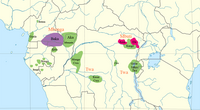
Photo from wikipedia
Abstract There is increasing evidence that abrupt vegetation shifts and large-scale erosive phases occurred in Central Africa during the third millennium before present. Debate exists as to whether these events… Click to show full abstract
Abstract There is increasing evidence that abrupt vegetation shifts and large-scale erosive phases occurred in Central Africa during the third millennium before present. Debate exists as to whether these events were caused by climate change and/or intensifying human activities related to the Bantu expansion. In this study, we report on a multi-proxy investigation of a sediment core (KZR-23) recovered from the Congo submarine canyon. Our aim was to reconstruct climate, erosion and vegetation patterns in the Congo Basin for the last 10,000 yrs, with a particular emphasis on the late Holocene period. Samples of modern riverine suspended particulates were also analyzed to characterize sediment source geochemical signatures from across the Congo watershed. We find that a sudden increase of bulk sediment aluminium-to-potassium (Al/K) ratios and initial radiocarbon ages of bulk organic matter occurred after 2,200 yrs ago, coincident with a pollen-inferred vegetation change suggesting forest retreat and development of savannas. Although hydrogen isotope compositions of plant waxes (δDwax) do not reveal a substantial hydroclimate shift during this period, neodymium isotopes and rare earth elements in detrital fractions indicate provenance changes for the sediment exported from the Congo Basin at that time, hence suggesting a reorganization of spatial rainfall patterns across Central Africa during this event. Taken together, these findings provide evidence for changing landscapes in Central Africa from about 2,200 yrs ago, associated with synchronous events of vegetation changes and enhanced erosion of pre-aged and highly weathered soils. These events coincided remarkably well with the arrival of Iron Age communities into the rainforest, as inferred from comparison to regional archaeological syntheses. While the human impact on the environment remains difficult to quantify at the scale of the vast Congo Basin, we tentatively propose that strengthening of El Nino-Southern Oscillation (ENSO) variability at that time played a key role in triggering the observed environmental changes, and possibly acted as a driver for the eastward migration of Bantu-speaking peoples across Central Africa.
Journal Title: Earth and Planetary Science Letters
Year Published: 2019
Link to full text (if available)
Share on Social Media: Sign Up to like & get
recommendations!